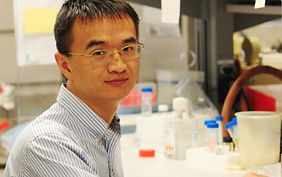
Epoxide hydrolase inhibition and Thiazolidinediones: A therapy for cardiometabolic syndrome
April 24, 2013
Bruce and his long time collaborator, John Imig from Medical College of Wisconsin and their team of scientists have determined the synergistic actions of inhibiting soluble epoxide hydrolase (sEH) with tAUCB (trans-4-(4-[3-adamantan-1-yl-ureid]-cyclohexyloxy)-benzoic acid) and activating peroxisome proliferator-activator receptorγ (PPARγ) with the thiazolidinedione rosiglitazone on the pathological progression of cardiometabolic syndrome. Cardiometabolic syndrome occurs with obesity and hypertension increasing the risks for cardiovascular disease and causing significant and rapidly progressive kidney disease.

Guodong's Key Discovery Involving Omega-3 Fatty Acids and Cancer
April 2, 2013
The team of 16 scientists led by Dr. Guodong has discovered a key mechanism by which dietary omega-3 fatty acids (fish oils) could reduce the tumor growth and spread of cancer. They also discovered cytochrome P450 epoxygenase metabolites of omega-3 fatty acid DHA or epoxy docosapentaenoic acids (EDPs) block blood supply to the tumor and thus inhibit tumor growth and metastasis. The research is to be published the week of April 1-5 in the Proceedings for the National Academy of Sciences (PNAS).
Other co-authors of the paper from this lab in addition to Bruce were Jun, Jun-Yan, Sing, Arzu and Sung Hee.

Preventing Cardiac Fibrosis
March 11, 2013
Research by Bruce and team shows that a new treatment may help prevent and reduce cardiac fibrosis, a common occurrence in patients after a heart attack. The research, in the lab of cardiologist and cell biologist Nipavan Chiamvimonvat of the School of Medicine’s Division of Cardiovascular Medicine, utilized a treatment involving a compound synthesized by Sing and Sung Hee in our lab. In research published this week in the PNAS, the 11-scientist team from the Chiamvimonvat and Hammock labs determined the molecular mechanisms underlying the beneficial effects of soluble epoxide hydrolase (sEH) inhibitors in a heart attack.
The Hammock/Chiamvimonvat collaborations earlier demonstrated the beneficial effects of several compounds that are potent inhibitors of the soluble epoxide hydrolase in different models of cardiac enlargement and heart failure. In this study, they treated murine (rodent) patients with the compound that resulted in “significant improvement in cardiac function after a heart attack.”